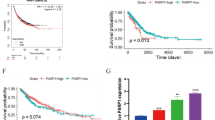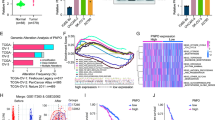Abstract
Purpose
Cholangiocarcinoma (CCA) is the second most malignant tumor of the hepatobiliary system. Due to its cumbersome early diagnosis and rapid progression, chemotherapy has become the main treatment option. Primary drug resistance is a major cause of the poor efficacy of chemotherapeutic drugs. Therefore, it is considered urgent to explore new drugs to overcome primary drug resistance of CCA.
Methods
Western blot and qRT-PCR assays were used to assess the expression of myotrophin (MTPN) and microRNA-885-5p (miR-885-5p) in CCA tissues and cells. The viability of CCA cells treated with arsenic trioxide (ATO), 5-fluorouracil (5-Fu) and cisplatin (CDDP) was analyzed using a CCK-8 assay. A luciferase reporter assay was used to assess the interaction between miR-885-5p and MTPN. Kaplan-Meier analyses were used for survival assessments.
Result
We found that ATO can reduce the resistance of CCA cells to 5-Fu and CDDP and promote the killing effect of 5-Fu and CDDP. Low-dose ATO showed an anti-drug-resistance effect through up-regulation of the expression of miR-885-5p. Combined with sequencing results and database predictions, we found that MTPN may serve as a direct target of miR-885-5p. After MTPN knockdown, the sensitivity of CCA cells to 5-FU and CDDP was increased. Finally, we found that ATO can reverse chemotherapy resistance induced by overexpression of MTPN.
Conclusion
Our data indicate that the ATO/miR-885-5p/MTPN axis may serve as a target for improving the sensitivity of CCA cells to chemotherapy.







Similar content being viewed by others
Data availability
Not applicable.
Abbreviations
- 5–:
-
Fu
- 5–:
-
Fluorouracil
- ATO:
-
arsenic trioxide.
- CCA:
-
cholangiocarcinoma.
- CDDP:
-
cisplatin.
- miRNAs:
-
microRNAs.
- MTPN:
-
myotrophin.
- ROS:
-
reactive oxygen species.
References
J.M. Banales, V. Cardinale, G. Carpino, M. Marzioni, J.B. Andersen, P. Invernizzi, G.E. Lind, T. Folseraas, S.J. Forbes, L. Fouassier, A. Geier, D.F. Calvisi, J.C. Mertens, M. Trauner, A. Benedetti, L. Maroni, J. Vaquero, R.I. Macias, C. Raggi, M.J. Perugorria, E. Gaudio, K.M. Boberg, J.J. Marin, D. Alvaro, Expert consensus document: Cholangiocarcinoma: current knowledge and future perspectives consensus statement from the European Network for the Study of Cholangiocarcinoma (ENS-CCA). Nat. Rev. Gastroenterol. Hepatol. 13, 261–280 (2016)
S. Rizvi, G.J. Gores, Pathogenesis, diagnosis, and management of cholangiocarcinoma. Gastroenterology 145, 1215–1229 (2013)
A.M. Lustri, S. Di Matteo, A. Fraveto, D. Costantini, A. Cantafora, C. Napoletano, M.C. Bragazzi, F. Giuliante, A.M. De Rose, P.B. Berloco, G.L. Grazi, G. Carpino, D. Alvaro, TGF-beta signaling is an effective target to impair survival and induce apoptosis of human cholangiocarcinoma cells: A study on human primary cell cultures. PLoS One 12, e0183932 (2017)
N. Razumilava, G.J. Gores, Cholangiocarcinoma. Lancet 383, 2168–2179 (2014)
F. Zhong, S. Zhang, C. Shao, J. Yang, X. Wu, Arsenic trioxide inhibits cholangiocarcinoma cell growth and induces apoptosis. Pathol. Oncol. Res. 16, 413–420 (2010)
D. Zhao, Y. Jiang, X. Dong, Z. Liu, B. Qu, Y. Zhang, N. Ma, Q. Han, Arsenic trioxide reduces drug resistance to adriamycin in leukemic K562/A02 cells via multiple mechanisms. Biomed. Pharmacother. 65, 354–358 (2011)
Y.Y. Zhao, L. Yu, B.L. Liu, X.J. He, B.Y. Zhang, Downregulation of P-gp, Ras and p-ERK1/2 contributes to the arsenic trioxide-induced reduction in drug resistance towards doxorubicin in gastric cancer cell lines. Mol. Med. Rep. 12, 7335–7343 (2015)
K.A. Boehme, J. Nitsch, R. Riester, R. Handgretinger, S.B. Schleicher, T. Kluba, F. Traub, Arsenic trioxide potentiates the effectiveness of etoposide in Ewing sarcomas. Int. J. Oncol. 49, 2135–2146 (2016)
J. Mao, L. Ma, Y. Shen, K. Zhu, R. Zhang, W. Xi, Z. Ruan, C. Luo, Z. Chen, X. Xi, S. Chen, Arsenic circumvents the gefitinib resistance by binding to P62 and mediating autophagic degradation of EGFR in non-small cell lung cancer. Cell Death Dis. 9, 963 (2018)
S. Modak, P. Zanzonico, J.A. Carrasquillo, B.H. Kushner, K. Kramer, N.K. Cheung, S.M. Larson, N. Pandit-Taskar, Arsenic trioxide as a radiation sensitizer for 131I-Metaiodobenzylguanidine therapy: Results of a phase II study. J. Nucl. Med. 57, 231–237 (2016)
G.X. Li, Q.L. Pei, Y. Gao, K.M. Liu, J.S. Nie, G. Han, Y.L. Qiu, W.P. Zhang, Protective effects of hepatocellular canalicular conjugate export pump (Mrp2) on sodium arsenite-induced hepatic dysfunction in rats. Exp. Toxicol. Pathol. 58, 447–453 (2007)
Z. Gregus, A. Gyurasics, I. Csanaky, Biliary and urinary excretion of inorganic arsenic: Monomethylarsonous acid as a major biliary metabolite in rats. Toxicol. Sci. 56, 8–25 (2000)
S. Zhang, C. Ma, H. Pang, F. Zeng, L. Cheng, B. Fang, J. Ma, Y. Shi, H. Hong, J. Chen, Z. Wang, J. Xia, Arsenic trioxide suppresses cell growth and migration via inhibition of miR-27a in breast cancer cells. Biochem. Biophys. Res. Commun. 469, 55–61 (2016)
Y.W. Chang, M.W. Chen, C.F. Chiu, C.C. Hong, C.C. Cheng, M. Hsiao, C.A. Chen, L.H. Wei, J.L. Su, Arsenic trioxide inhibits CXCR4-mediated metastasis by interfering miR-520h/PP2A/NF-kappaB signaling in cervical cancer. Ann. Surg. Oncol. 21(Suppl 4), S687–S695 (2014)
L. Tang, Y. Wang, H. Wang, B. Xu, H. Ji, G. Xu, X. Ge, Q. Li, L. Miao, Long noncoding-RNA component of mitochondrial RNA processing endoribonuclease is involved in the progression of cholangiocarcinoma by regulating microRNA-217. Cancer Sci. 110, 2166–2179 (2019)
F. Xu, J.J. Yan, Y. Gan, Y. Chang, H.L. Wang, X.X. He, Q. Zhao, miR-885-5p negatively regulates Warburg effect by silencing hexokinase 2 in liver cancer. Mol. Ther. Nucleic Acids 18, 308–319 (2019)
C. Li, X. Wang, Q. Song, MicroRNA 885-5p inhibits hepatocellular carcinoma metastasis by repressing AEG1. Onco. Targets Ther. 13, 981–988 (2020)
S. Sen, G. Kundu, N. Mekhail, J. Castel, K. Misono, B. Healy, Myotrophin: Purification of a novel peptide from spontaneously hypertensive rat heart that influences myocardial growth. J. Biol. Chem. 265, 16635–16643 (1990)
E.Y. Kim, S.S. Lee, J.H. Shin, S.H. Kim, D.H. Shin, S.Y. Baek, Anticancer effect of arsenic trioxide on cholangiocarcinoma: In vitro experiments and in vivo xenograft mouse model. Clin. Exp. Med. 14, 215–224 (2014)
P.R. Subbarayan, B. Ardalan, In the war against solid tumors arsenic trioxide needs partners. J. Gastrointest Cancer 45, 363–371 (2014)
J. Gao, G. Wang, J. Wu, Y. Zuo, J. Zhang, X. Jin, Skp2 expression is inhibited by arsenic trioxide through the upregulation of miRNA-330-5p in pancreatic cancer cells. Mol. Ther. Oncolytics 12, 214–223 (2019)
X. Bao, T. Ren, Y. Huang, S. Wang, F. Zhang, K. Liu, B. Zheng, W. Guo, Induction of the mesenchymal to epithelial transition by demethylation-activated microRNA-125b is involved in the anti-migration/invasion effects of arsenic trioxide on human chondrosarcoma. J. Exp. Clin. Cancer Res. 35, 129 (2016)
L. Zhu, F. Huang, G. Deng, W. Nie, W. Huang, H. Xu, S. Zheng, Z. Yi, T. Wan, MicroRNA-212 targets FOXA1 and suppresses the proliferation and invasion of intrahepatic cholangiocarcinoma cells. Exp. Ther. Med. 13, 2109 (2017)
H. Li, Z.Q. Zhou, Z.R. Yang, D.N. Tong, J. Guan, B.J. Shi, J. Nie, X.T. Ding, B. Li, G.W. Zhou, Z.Y. Zhang, MicroRNA-191 acts as a tumor promoter by modulating the TET1-p53 pathway in intrahepatic cholangiocarcinoma. Hepatology 66, 136–151 (2017)
E. Borgmastars, H.A. de Weerd, Z. Lubovac-Pilav, M. Sund, miRFA: an automated pipeline for microRNA functional analysis with correlation support from TCGA and TCPA expression data in pancreatic cancer. BMC Bioinf. 20, 393 (2019)
Y. Liu, Z. Bao, W. Tian, G. Huang, miR-885-5p suppresses osteosarcoma proliferation, migration and invasion through regulation of beta-catenin. Oncol. Lett. 17, 1996–2004 (2019)
E.A. Afanasyeva, P. Mestdagh, C. Kumps, J. Vandesompele, V. Ehemann, J. Theissen, M. Fischer, M. Zapatka, B. Brors, L. Savelyeva, V. Sagulenko, F. Speleman, M. Schwab, F. Westermann, MicroRNA miR-885-5p targets CDK2 and MCM5, activates p53 and inhibits proliferation and survival. Cell Death Differ. 18, 974–984 (2011)
N.A. Hussein, Z.A. Kholy, M.M. Anwar, M.A. Ahmad, S.M. Ahmad, Plasma miR-22-3p, miR-642b-3p and miR-885-5p as diagnostic biomarkers for pancreatic cancer. J. Cancer Res. Clin. Oncol. 143, 83–93 (2017)
J. Gui, Y. Tian, X. Wen, W. Zhang, P. Zhang, J. Gao, W. Run, L. Tian, X. Jia, Y. Gao, Serum microRNA characterization identifies miR-885-5p as a potential marker for detecting liver pathologies. Clin. Sci. (Lond.). 120, 183–193 (2011)
S.Q. Khan, D. Kelly, P. Quinn, J.E. Davies, L.L. Ng, Myotrophin is a more powerful predictor of major adverse cardiac events following acute coronary syndrome than N-terminal pro-B-type natriuretic peptide. Clin. Sci. (Lond). 112, 251–256 (2007)
R.J. O'Brien, I. Loke, J.E. Davies, I.B. Squire, L.L. Ng, Myotrophin in human heart failure. J. Am. Coll. Cardiol. 42, 719–725 (2003)
A. Jafarian, M. Taghikani, S. Abroun, A. Allahverdi, M. Lamei, N. Lakpour, M. Soleimani, The generation of insulin producing cells from human mesenchymal stem cells by MiR-375 and Anti-MiR-9. PLoS One 10, e0128650 (2015)
Y. Li, X. Xu, Y. Liang, S. Liu, H. Xiao, F. Li, H. Cheng, Z. Fu, miR-375 enhances palmitate-induced lipoapoptosis in insulin-secreting NIT-1 cells by repressing myotrophin (V1) protein expression. Int. J. Clin. Exp. Pathol. 3, 254–264 (2010)
M.A. Muniz Lino, Y. Palacios-Rodriguez, S. Rodriguez-Cuevas, V. Bautista-Pina, L.A. Marchat, E. Ruiz-Garcia, H. Astudillo-de la Vega, A.E. Gonzalez-Santiago, A. Flores-Perez, J. Diaz-Chavez, A. Carlos-Reyes, E. Alvarez-Sanchez, C. Lopez-Camarillo, Comparative proteomic profiling of triple-negative breast cancer reveals that up-regulation of RhoGDI-2 is associated to the inhibition of caspase 3 and caspase 9. J. Proteomics 111, 198–211 (2014)
B. Das, S. Gupta, A. Vasanji, Z. Xu, S. Misra, S. Sen, Nuclear co-translocation of myotrophin and p65 stimulates myocyte growth. Regulation by myotrophin hairpin loops J. Biol. Chem. 283, 27947–27956 (2008)
Funding
This work was supported by National 13th Five-Year key Research & Development plan precision medical project subproject (2017YFC 0908304) and the Key Medical Talents of Jiangsu Province.
Author information
Authors and Affiliations
Contributions
LM, QL and QJ conceived the research. YW and QL drafted the manuscript. LM, QL and QJ critically reviewed and revised the manuscript. YW, WZ, LC and SX performed the experiments. LT and YY collected the clinical samples and analyzed the data. All authors have read and approved the final version of the manuscript.
Corresponding authors
Ethics declarations
Ethics approval and consent to participate
This study has been conducted in accordance with ethical standards and according to the Declaration of Helsinki and national and international guidelines, and has been approved by the authors’ institutional review board. The study protocol was approved by the Medical Ethics Committee of Nanjing Medical University.
Consent for publication
Not applicable.
Disclosure statement
The authors have no conflict of interest.
Additional information
Publisher’s note
Springer Nature remains neutral with regard to jurisdictional claims in published maps and institutional affiliations.
Supplementary Information
Fig. S1
The filter of miRNAs: (A) Heatmap of differentially expressed microRNAs (B): Six microRNAs were selected as the detection target of cells and tissues according to the difference multiple.) (PNG 86 kb)
Fig. S2
The filtered mRNAs (PNG 82 kb)
Fig. S3
IC50 of the cells transfected with miR-196a-5p inhibitor or not: ((A) RBE and HCCC-9810 were transfected by scrambled or miR-196a-5p inhibitor, IC50 of 5-FU (top) or CDDP (bottom) in them were analyzed.) (PNG 157 kb)
Fig. S4
The effect of MTPN siRNAs (PNG 52 kb)
Fig. S5
The primers. (The samples of TCGA were available from: https://www.cancer.gov/about-nci/organization/ccg/research/structural-genomics/tcga) (PNG 20 kb)
Table S1
The CCA tissue patient group and characteristics. (PNG 20 kb)
Rights and permissions
About this article
Cite this article
Wang, Y., Zhang, W., Chen, L. et al. The ATO/miRNA-885-5p/MTPN axis induces reversal of drug-resistance in cholangiocarcinoma. Cell Oncol. 44, 907–916 (2021). https://doi.org/10.1007/s13402-021-00610-3
Accepted:
Published:
Issue Date:
DOI: https://doi.org/10.1007/s13402-021-00610-3




